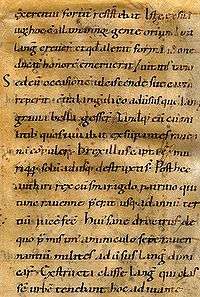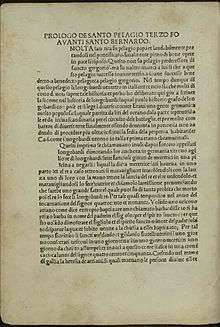History of the Lombards
The History of the Lombards or the History of the Langobards (Latin: Historia Langobardorum) is the chief work by Paul the Deacon, written in the late 8th century. This incomplete history in six books was written after 787 and at any rate no later than 796, maybe at Montecassino.[4]
| History of the Lombards | |
|---|---|
| Historia Langobardorum Historia gentis Langobardorum | |
 Salzburg manuscript | |
| Author(s) | Paul the Deacon |
| Language | Latin |
| Date | 787–796[1] |
| Provenance | Monte Cassino[2][3] |
| Manuscript(s) | 115 extant manuscripts |
| Principal manuscript(s) | Codex Sangallensis 635 |
| First printed edition | 1514 |
| Genre | Ethnic history |
| Subject | History of the Lombard people |
The history covers the story of the Lombards from their mythical origins to the death of King Liutprand in 743, and contains much information about the Eastern Roman empire, the Franks, and others. The story is told from the point of view of a Lombard patriot and is especially valuable for its treatment of the relations between the Franks and the Lombards. As his primary sources, Paul used the document called the Origo gentis Langobardorum, the Liber pontificalis, the lost history of Secundus of Trent, and the lost annals of Benevento; he also made free use of works by Bede, Gregory of Tours, and Isidore of Seville.[4]
Editions
According to a study made by Laura Pani in 2000, there are 115 surviving codices of Paul's history. A popular work in the Middle Ages, as indicated by the number of copies and their dissemination throughout Western Europe, more than twenty of these manuscripts predate the 11th century while another eighty or more were copied later.[5]
The relations between these manuscripts were studied by Georg Waitz, who in 1876 identified 11 different families of the Historia Langobardorum.[5] The oldest manuscript is the Palimpsest of Assisi, written in the uncial script towards the end of the 8th century, almost immediately after Paul's work was completed. This palimpsest is, however, far from complete, as it contains only parts of books II and V of Paul's history. The earliest complete manuscript is the Codex Sangallensis 635 written sometime between the 8th and the 10th centuries and designated by Waitz as F1.[6] According to Waitz, F1's age makes it the most reliable of the Historia's codices, a view which has been challenged by Antonio Zanella and Dante Bianchi, both of whom hold that the F1 does not correctly reflect Paul's original.[7]

Paul's account was largely accepted by subsequent writers, was often continued, and was first printed in Paris in 1514. Among the printed editions of the Latin text, the most authoritative is that edited by Ludwig Konrad Bethmann and Georg Waitz and published in the Monumenta Germaniae Historica. Scriptores rerum langobardicarum et Italicarum (Hanover, 1878).[4]
Translations
It has been translated into English, German, French, Polish, Spanish, Swedish, Italian, Aragonese, Slovenian and Croatian, the English translation being by W.D. Foulke (Philadelphia, 1906), the German by O. Abel and R. Jacobi (Leipzig, 1878),[4] the Polish by Ignacy Lewandowski (1995, Warszawa), Henryk Pietruszczak, (2002, Zgorzelec), the Spanish by P. Herrera (Cádiz, 2006), and the Swedish by Helge Weimarck (Stockholm, 1971).
Several versions of the English translation are available (see below in the section Further reading).
Into Italian
- L. Domenichi, Paulo Diacono della Chiesa d'Aquileia della Origine e Fatti dé Re Longobardi (Venice, 1548)[8]
- A. Viviani, Dell' origine e de' fatti de' Longobardi, 2 vols. (Udine, 1826‑28)
- G. S. Uberti, De' fatti de' Longobardi (Cividale, 1899), reprinted in the Biblioteca Popolare Sonzogno (Milan, 1915)
- M. Felisatti, Storia dei Longobardi (Milan, 1967)
- F. Roncoroni, Storia dei Longobardi (Milan, 1971)
- E. Bartolini, Historia Langobardorum with Latin text and translation by A. Giacomini (Udine, n.d.)
- A. Zanella, Storia dei Longobardi (Milan, 1991)
- L. Capo (ed.), Storia dei Longobardi (Milan, 1992)
Notes
- Pohl 2008, p. 93
- Capo 1993, p. xxviii
- Bullough 1991, p. 137
- Chisholm 1911, p. 964.
- McKitterick 2004, p. 77-78
- Zanella 2007, p. 105
- Zanella 2007, pp. 105–106
- Osmont 1768, p. 244–245.
References
- Osmont, Jean Baptiste Louis (1768). Dictionnaire typographique, historique et critique. Paris: Lacombe. pp. 244–245.
Dictionnaire typographique, historique et critique des livres rares, singuliers.
CS1 maint: ref=harv (link)
- McKitterick, Rosamond (2004). History and Memory in the Carolingian World. Cambridge: Cambridge University Press. doi:10.1017/CBO9780511617003.
- Bibliography in «Geschichtsquellen des deutschen Mittelalters» («Historical Sources of the German Middle Ages») repertory.
Attribution:

Further reading
- Paul the Deacon (2003). Peters, Edward (ed.). History of the Lombards. Translated by Foulke, William Dudley. Philadelphia: University of Pennsylvania Press. ISBN 0812210794.
- Paul the Deacon (1907). History of the Lombards. Translated by Foulke, William Dudley. University of Pennsylvania. — A facsimile (and other formats) published online by the Internet Archive
- Paul the Deacon (1907). History of the Lombards. Translated by Foulke, William Dudley. University of Pennsylvania. Archived from the original on 2016-07-29. Retrieved 2010-07-22. — A machine readable version published online by the New Northvegr Center (2009)
- Paul the Deacon (1907). History of the Lombards. Translated by Foulke, William Dudley. University of Pennsylvania. — Machine readable online Latin-English facing text, published by germanicmythology.com (January 2016) "Resources for Researchers into Germanic Mythology, Norse Mythology, and Northern European Folklore"
External links
| Latin Wikisource has original text related to this article: |
- Schlager, Patricius (1911). . In Herbermann, Charles (ed.). Catholic Encyclopedia. 11. New York: Robert Appleton Company.
- Works of Paulus Diaconus at Bibliotheca Augustana (in Latin)
- Paul's Historia Langobardorum at the Institut für Mittelalterforschung (in Latin)
- Historia Langobardorum, overview and full reproduction of the codex: Cividale del Friuli, Museo Archeologico Nazionale, XXVIII.